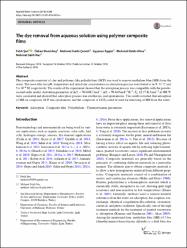| dc.contributor.author | Şen, Fatih | |
| dc.contributor.author | Demirbaş, Özkan | |
| dc.contributor.author | Çalımlı, Mehmet Harbi | |
| dc.contributor.author | Aygün, Ayşenur | |
| dc.contributor.author | Alma, Mehmet Hakkı | |
| dc.contributor.author | Nas, Mehmet Salih | |
| dc.date.accessioned | 2019-06-12T07:21:55Z | |
| dc.date.available | 2019-06-12T07:21:55Z | |
| dc.date.issued | 2018 | en_US |
| dc.identifier.issn | 2190-5487 | |
| dc.identifier.issn | 2190-5495 | |
| dc.identifier.uri | https://doi.org/10.1007/s13201-018-0856-x | |
| dc.identifier.uri | https://hdl.handle.net/20.500.12462/5430 | |
| dc.description | Demirbaş, Özkan (Balikesir Author) | en_US |
| dc.description.abstract | The composite consisted of clay and polymers like polyethylene (GCP) was used to remove methylene blue (MB) from the water. The most effective pH, temperature and initial dye concentration in adsorption process were found to be 9, 55 degrees C and 5x10(-6)M, respectively. The results of the experiment showed that the adsorption process was compatible with the pseudo-second-order model. Activation parameters of G: -70.64KJmol(-1), S: -70.64Jmol(-1)K(-1), E-a: 12.37KJmol(-1) at 308 degrees C were calculated and showed that adsorption process was exothermic and spontaneous. The results revealed that adsorption of MB on composite GCP was spontaneous and the composite of GCP(f) could be used for removing of MB from the water. | en_US |
| dc.language.iso | eng | en_US |
| dc.publisher | Springer Heidelberg | en_US |
| dc.relation.isversionof | 10.1007/s13201-018-0856-x | en_US |
| dc.rights | info:eu-repo/semantics/openAccess | en_US |
| dc.subject | Thermal-Decomposition Method | en_US |
| dc.subject | Visible-Light | en_US |
| dc.subject | Methylene-Blue | en_US |
| dc.subject | Photocatalytic Activity | en_US |
| dc.subject | Graphene Oxide | en_US |
| dc.subject | Induced Degradation | en_US |
| dc.subject | Textile Effluents | en_US |
| dc.subject | Titanium-Dioxide | en_US |
| dc.subject | Carbon Nanotubes | en_US |
| dc.subject | Activated Carbon | en_US |
| dc.title | The dye removal from aqueous solution using polymer composite films | en_US |
| dc.type | article | en_US |
| dc.relation.journal | Applied Water Science | en_US |
| dc.contributor.department | Fen Edebiyat Fakültesi | en_US |
| dc.contributor.authorID | 0000-0001-9756-191X | en_US |
| dc.contributor.authorID | 0000-0001-6843-9026 | en_US |
| dc.identifier.volume | 8 | en_US |
| dc.identifier.issue | 7 | en_US |
| dc.identifier.startpage | 1 | en_US |
| dc.identifier.endpage | 9 | en_US |
| dc.relation.publicationcategory | Makale - Uluslararası Hakemli Dergi - Kurum Öğretim Elemanı | en_US |


















